One of the heartwarming stories out of the recently completed 2024 Olympic Games involves men’s gymnastics, specifically the pommel horse. It’s about Stephen Nedoroscik, the Clark Kent engineering grad who whipped off his thick glasses right before his team competition routine and turned into a pommel-horse superhero, clinching the bronze medal for the US team and giving major street cred to the bespectacled everywhere.
At Gray DI, we have our own bronze medalist. Our breaking story comes from our Program Evaluation System (PES) Markets US Program Ranking.
Before diving into one, PES lets you evaluate all academic program options for market demand. It scores and assigns a percentile rank for over 1,400 programs, making it easy to spot those in promising markets that might be worth a closer look. In this instance, a Bachelor’s in Mechanical Engineering ranks as the third-highest-performing academic program overall for student demand, employment opportunities, and competition, which earns the bronze medal behind Computer Science and Cyber Security. Honorable mention to five additional engineering programs ranked in the 97-99th percentile.
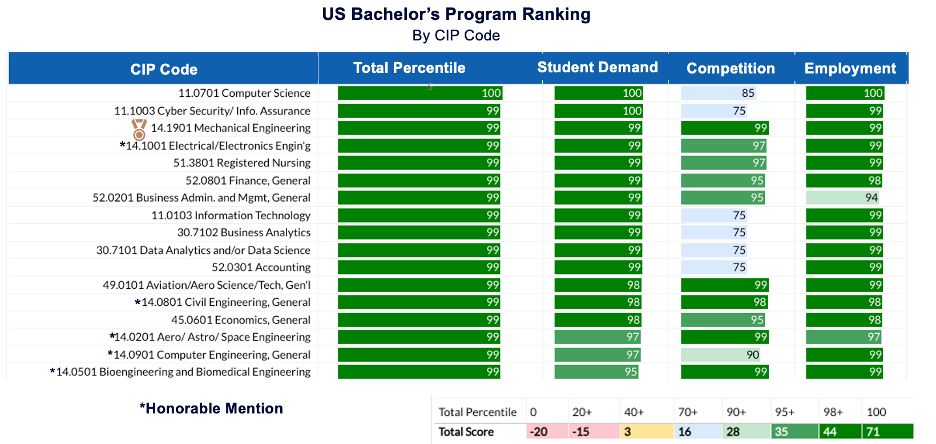 Source: Gray DI Program Evaluation System: Markets
Source: Gray DI Program Evaluation System: Markets
Let’s take a closer look at what is driving these winning program performances.
Student Demand for Engineering Programs
New enrollment for all engineering programs took a dive in the Covid years but shows signs of returning to pre-Covid numbers. It increased an average of two percent annually from the academic years 2020-21 to 2023-24.
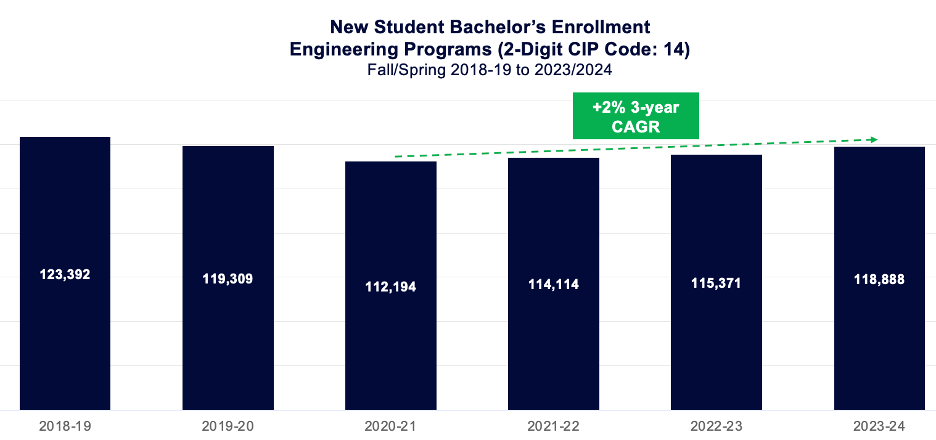 Source: Gray DI Program Enrollment Dashboard with data from National Student Clearinghouse
Source: Gray DI Program Enrollment Dashboard with data from National Student Clearinghouse
Mechanical Engineering had the highest new enrollment in 2023-24 with 24,685 first-time students, but it wasn’t the fastest-growing program. Computer Software Engineering is a much smaller program, but new enrollment increased 18 percent year-over-year. The second largest program was Engineering, General, with 22,540 first-time students, yet it fell four percent year-over-year. Environmental Health Engineering, with 1,977 new students, also fell four percent.
 Source: Gray DI Program Enrollment Dashboard
Source: Gray DI Program Enrollment Dashboard
Another data source for Student Demand is Google keyword searches for academic programs. Searches indicate what students are interested in now (the data is updated monthly) and contribute insights into future program enrollment. The chart below illustrates year-over-year growth in Google searches for Engineering programs with at least 10,000 searches in June 2024.
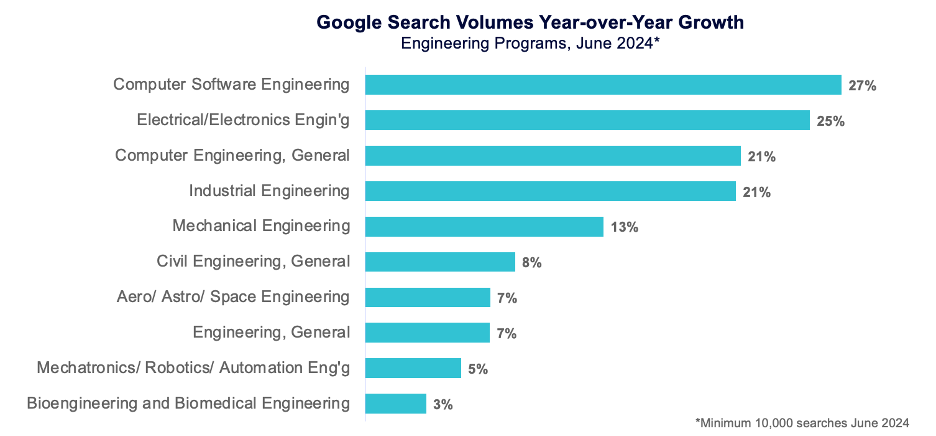 Source: Gray DI Keyword Search Dashboard
Source: Gray DI Keyword Search Dashboard
Employment for Engineering Graduates
In June 2024, US total job postings grew 24 percent year-over-year. At the bachelor’s award level, four occupations in engineering made the 10 fastest-growing job postings.
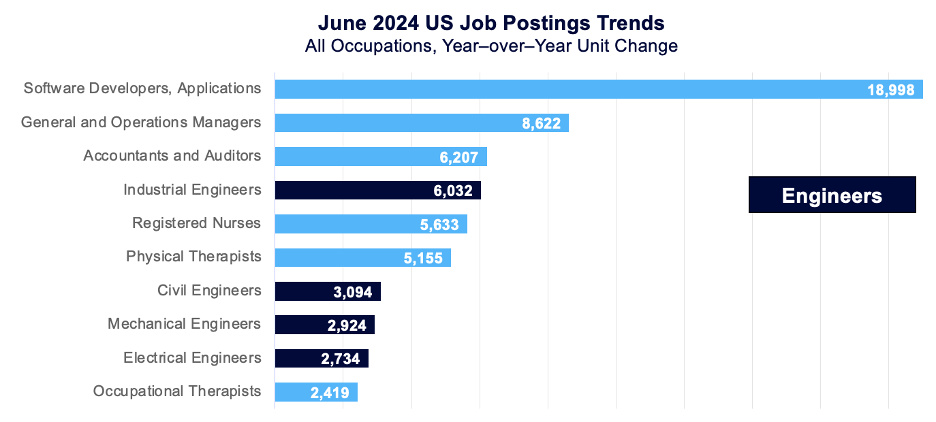 Source: Gray DI Job Postings Insights Dashboard
Source: Gray DI Job Postings Insights Dashboard
All engineers on this list had strong positive growth in June year-over-year… in all 50 states.
Wages are also favorable for engineering graduates. The lowest median wage post-entry-level (four years after the first job) is almost $95,000 for Mechatronics/Robotics/Automation Engineering. The highest median is for Computer Hardware Engineering, with a post-entry median wage of more than $111,000.
Source: Gray DI Program Evaluation: Markets with data from IPEDS
Competition
A large number of campuses have produced engineering graduates, but this isn’t necessarily a sign of a saturated market. For example, in 2022, 373 institutions graduated students in Mechanical Engineering. Even with the relatively high number of competitors, program sizes are large (99th percentile) compared to all other bachelor’s programs. The median program size was 66 completions in 2022, and the average was even higher at 94. Only 10 percent of programs had under 50 students. There may be room for additional institutions to establish an engineering program and attract students.
Further, this is primarily an on-ground program. You wouldn’t be competing for students with large national online universities like Western Governors University or Southern New Hampshire University.
The table below is a sample of popular engineering programs with indicators of new program viability.
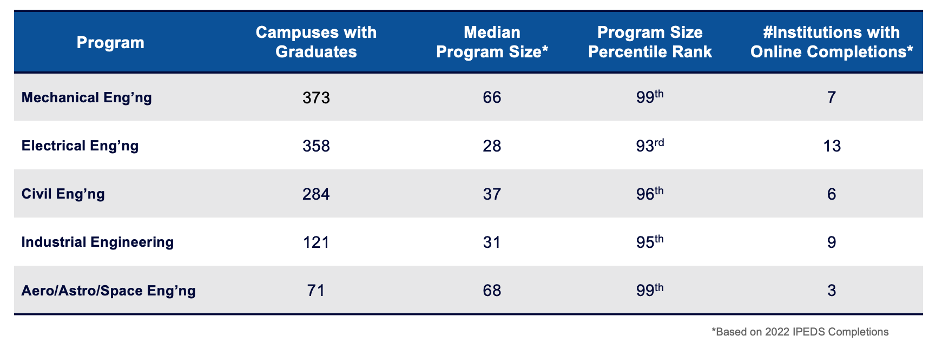 Source: Gray DI Program Evaluation System: Markets with data from IPEDS
Source: Gray DI Program Evaluation System: Markets with data from IPEDS
Perhaps the influence of the Olympic superhero engineer on the pommel horse will help sustain the upward market trends for Engineering programs. Robust student demand, strong employment opportunities and wages, and favorable competition indicate a high potential program to start or grow at your institution.




